Organizing a refrigerator – 13 hygienic ways to keep food fresh for longer
If you know how to organize a refrigerator properly, you can ensure your food stays fresh for longer and avoid cross-contamination
- (opens in new tab)
- (opens in new tab)
- (opens in new tab)
- Sign up to our newsletter Newsletter
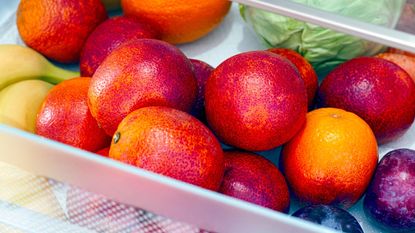
Organizing a refrigerator is an on-going battle in most households. We’ve all been guilty of getting home exhausted from a big shop and just cramming everything in. Even when groceries are delivered, refrigerator filling is generally done in a hurry, with a million other more pressing tasks on your mind.
‘Sometimes getting the groceries away is a chore in itself, without worrying about making sure everything fits and is easy to access,’ says Cesar Fernandez, home economist at Miele. ‘But there’s more to re-stocking your refrigerator than you may think. Having a well-organized refrigerator will not only make everything easier to find but it also keeps it fresher, reduces waste and saves money.’
Gaining and maintaining order inside your refrigerator will also result in speedier meal preparation. You may even be inspired to create more interesting dishes, rather than grabbing the first items to hand. At the very least, a neatly organized refrigerator will help reduce the times you automatically buy more cheese or butter, only to discover there are three blocks already in-stock. So, if you are organizing a kitchen this weekend, add organizing a refrigerator to your list.
Organizing a refrigerator
Organizing a refrigerator is best done when you have at least an hour or two to spare. Alternatively, commit to tackling one shelf a week until everything is intuitively arranged according to ideal temperature, convenience, and visibility.
'The storage of food is vital in terms of trying to maximize its longevity. The way in which you organize your fridge can be detrimental when it comes to food wastage. There are certain ways you should store your food away in order to ensure all food in your fridge is used and waste is minimal,' says expert, Jamie Griffin at InSinkErator (opens in new tab).
Next establish a system designed to maintain order, which should include regularly checking use-by dates and wiping down surfaces. If your family is guilty of only reaching for the freshest ingredients or snacks, consider establishing an ‘eat me first’ shelf or container, and ask them not to open new treats unless it is empty.
Whether you are rearranging your existing refrigerator or are planning on buying a refrigerator, we’ve got top advice from the experts as well as a host of tips on how to organize a refrigerator below.
1. Organize food by use-by date
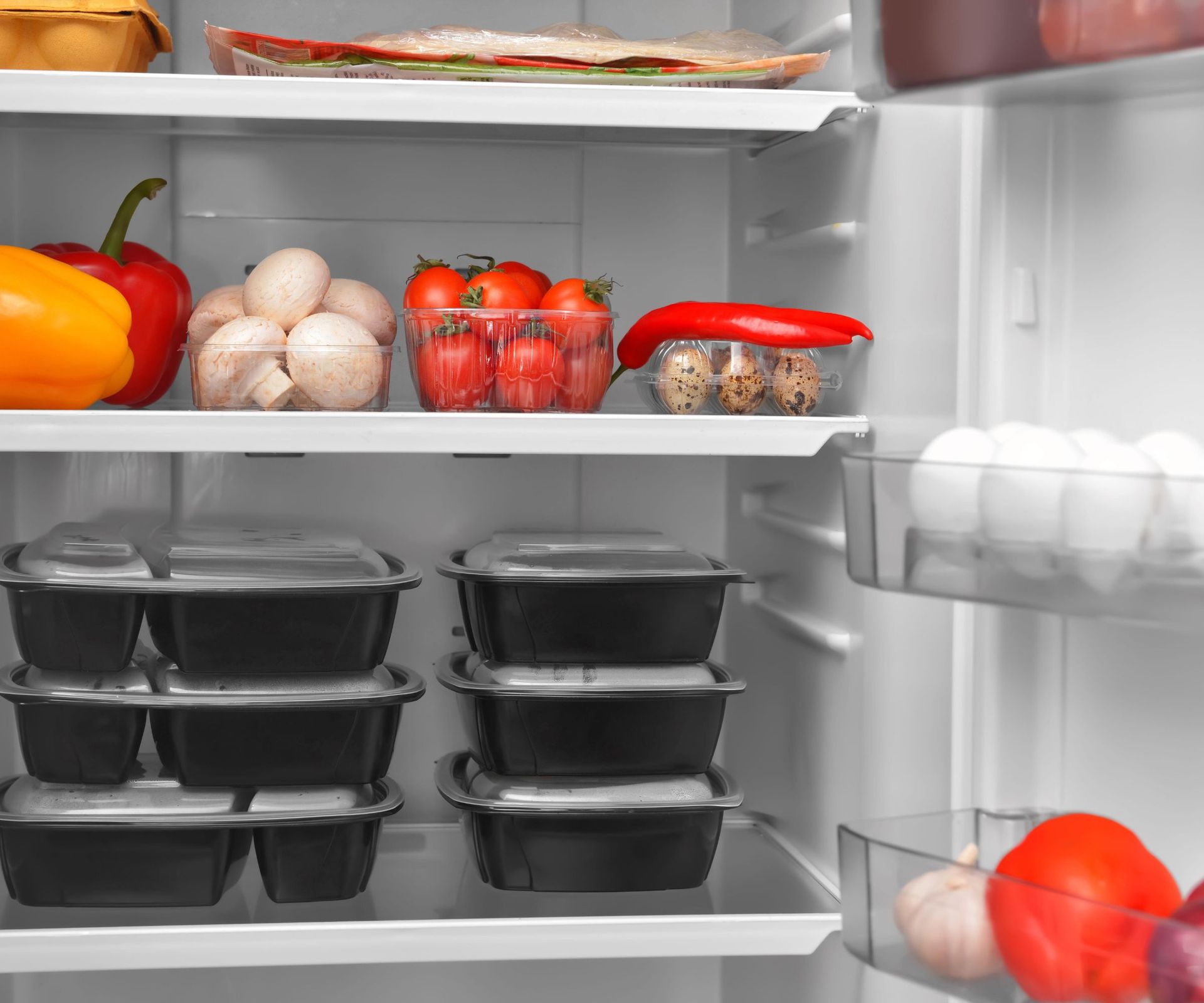
'When putting your groceries away, ensure to put it in date order with the shortest dates at the front and the longer dates at the back – this will help you to prioritize the foods that need to be used the soonest,' says Jamie Griffin. 'Prior to putting your groceries away, remember to rotate what you already have in your fridge. We advise rotating the contents of your fridge every couple of days to ensure everything is in date and to minimize food waste.'
2. Label leftovers
Keep a marker near the refrigerator to help yourself make this happen.
'There is nothing worse than forgetting how long leftovers have been in the fridge for. In order to combat this, label the leftovers you put in your refrigerator with the date it was stored in order to reduce food waste,' says Jamie Griffin.
3. Store by shelf position

The most important consideration when organizing a refrigerator to store chilled foods is the temperature difference between the top and bottom shelves. Newer refrigerators have better air flow control, but the simple fact is that hot air rises, so the top of your refrigerator will always be slightly warmer than the bottom. The upper shelf is best for anything that doesn’t need cooking.
‘Think deli items, snacks and prepared salad pots,’ says Miele (opens in new tab)’s home economist Cesar Fernandez. The middle shelves are perfect for dairy produce, such as cheese, butter and yoghurt, while the bottom shelf – the coolest – is where you keep raw foods like meat and fish.
Keeping track of expiration dates – just as you do when organizing a pantry – is a must-do task. ‘Check the labels every now and then to make sure you move anything that should be eaten soon to the front. Keep longer "use by" dates towards the back and rotate on a regular basis as you add new items,’ adds Cesar.
4. Save higher shelves for less perishable items
'The shelves higher up in your refrigerator are perfect for storing dairy products and the food items which are less prone to spoilage,' says Jamie Griffin. 'Don’t forget about the shelves on the doors of your fridge – this is the perfect place for storing chilled drinks and condiments.'
5. Adjust your shelves
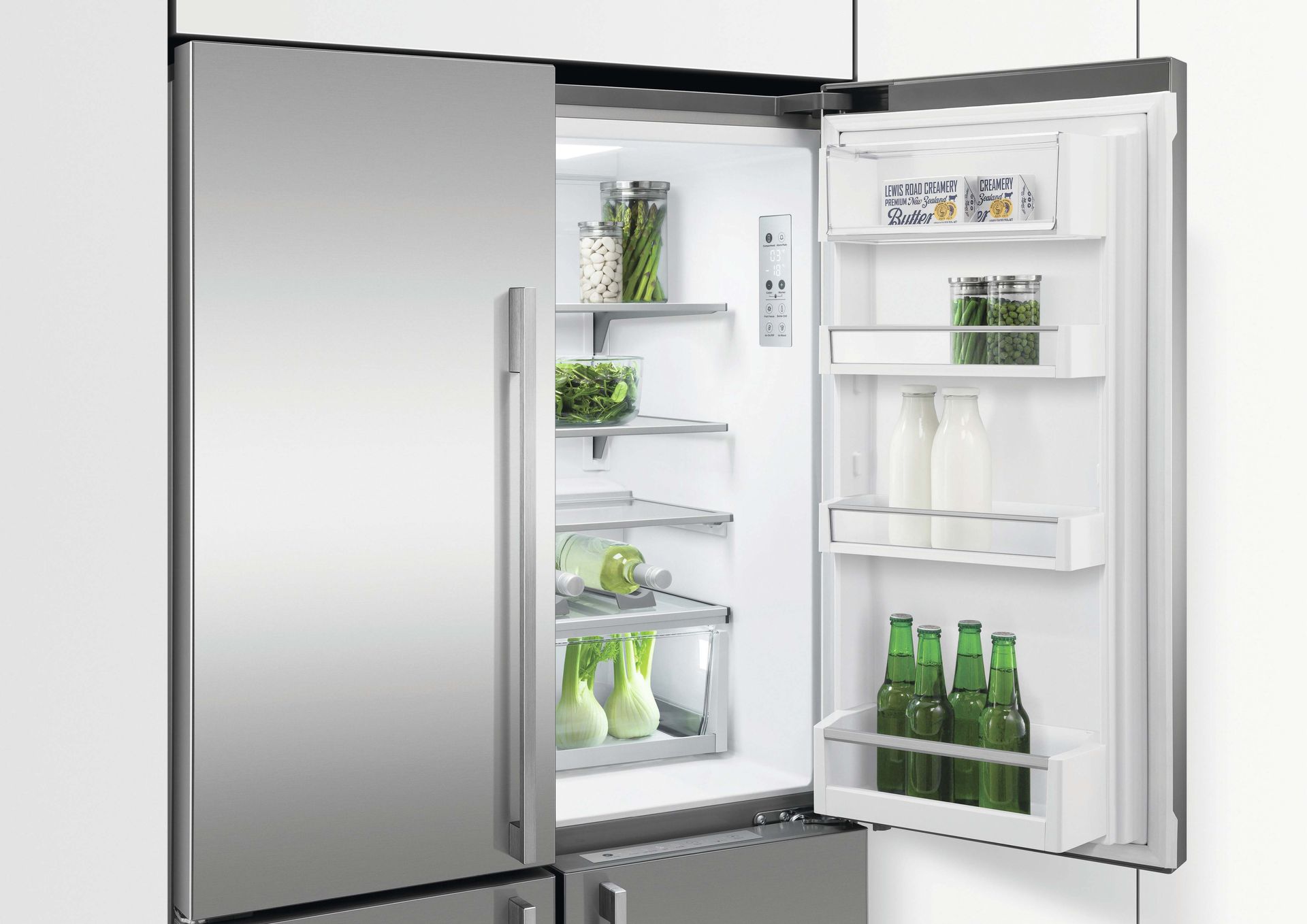
‘Possibly the easiest yet often overlooked way to get the most food shopping into your refrigerator is to arrange produce of similar heights on the same shelves, rather than storing a mish-mash of different height items side-by-side,’ says Luisa Jamieson, food scientist for Fisher & Paykel (opens in new tab). ‘Organizing by height means the shelves can then be adjusted, and any wasted space is eliminated.’ This idea works best with foods of the same type, such as the condiment shelf for example. Don’t put raw meat next to cooked ham just because it’s the same height!
6. Don't overload it
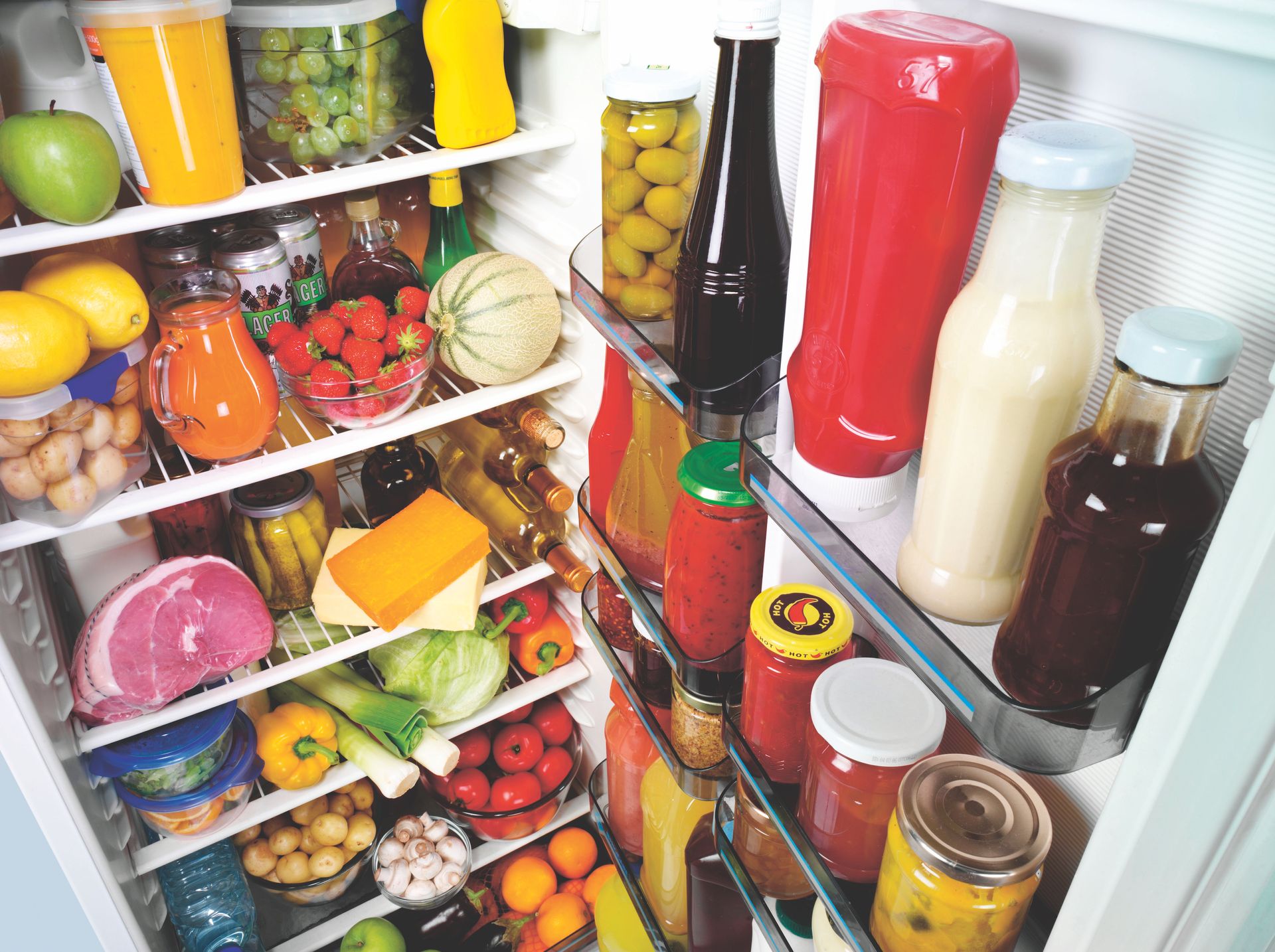
It’s key when organizing kitchen drawers and organizing kitchen cabinets as well as when you’re organizing kitchen countertops: don’t overfill the space.
‘A well-organized refrigerator is one that does its job properly and keeps food fresher for longer, ultimately reducing food waste. One key tip is not to overfill it – if you pack food in so much that the air can’t circulate, the contents won’t keep as cool, which could reduce their lifespan,’ says Valerie Posner, cooling manager at Bosch Home Appliances (opens in new tab).
Cramming food into every inch can also result in blocked air vents, which in turn reduces energy efficiency. Declutter regularly and think big. ‘This is where a larger refrigerator is great – not just for families, but for anyone who wants to buy in bulk, as you don’t need to shop as often,’ adds Valerie.
However, if you really don’t need much refrigeration, do switch to a smaller appliance. Running a large near-empty fridge means it has to work very hard to cool just a few items, ultimately wasting electricity. Aim to keep your refrigerator around two-thirds full. Add a few bottles or containers of cold water towards grocery shopping day when supplies get low. Once chilled they will help keep your fridge running efficiently.
7. Understand crisper drawers
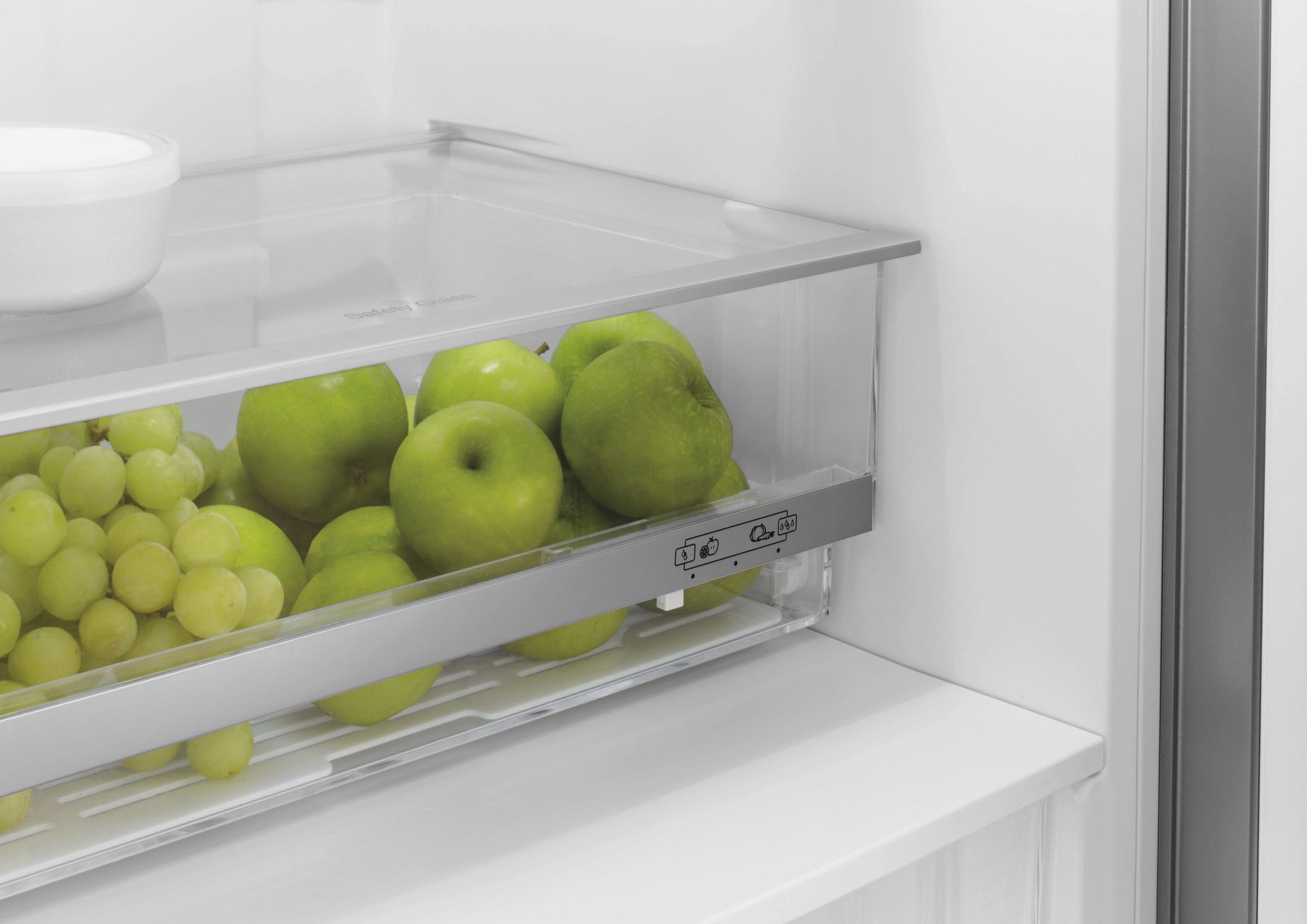
Most refrigerators come with at least two crisper bins, also known as humidity drawers, which are designed to extend the lifespan of fruit and veg, but do you know how to use them correctly? It may be tempting to pop some items from an overflowing veg drawer into the emptier fruit side, but you should resist. The vegetable drawer is designed for high-humidity produce – greens fair better when there’s moisture around – while the fruit drawer is low humidity, which protects fruit from premature ageing.
You also need to understand ethylene when organizing a refrigerator. ‘Ethylene is a gas produced by some fruit and vegetables that causes other produce to ripen faster. An example of this is avocados, which can speed up the ripening process of bananas too quickly when stored together,’ explains Luisa Jamieson, food scientist for Fisher & Paykel. Separate ethylene-sensitive produce, such as asparagus, broccoli, cucumber, leafy greens, strawberries and raspberries, from ethylene producers, like pears, avocados, melons, kiwi, mango and tomatoes.
If you only keep a few ethylene producers in your refrigerator and don’t want to dedicate a whole crisper drawer to them, simply store in a paper bag or box elsewhere within the fridge.
8. Think about what you store in the doors

As the door shelves are the warmest storage point of any fridge, they’re best reserved for items with natural preservatives, like jams, chutneys, salad dressings and long-life juices. Anything with high levels of vinegar, salt or sugar in the ingredients is a good choice (think items that only require refrigerating once opened).
While the lowest door shelf is often a convenient size and height to store milk and juice that’s currently open (the upright position reduces the issue of leaky lids), don’t use it for bulk buys. Any extra bottles or drink cartons bought with the same use-by-date will last longer if stored on the middle shelves.
9. Stack bottles and cans

If you don’t have the luxury of a separate wine cooler, beverage bottles and cans can take up a lot of precious refrigerator space. Stacking is the solution.
Buy cans in ‘refrigerator friendly’ boxes, which are designed to open from the end and allow multiple cans to be squeezed into a small footprint. You can also get specialist refrigerator racks, in universal sizes to fit standard appliances, that are designed to stack wine bottles and any other round bottles, on top of each other. Do make sure bottle caps are screwed tight before you store them horizontally to prevent messy spills.
10. Keep raw meat low down

The ideal temperature for a refrigerator is between 37°F (3°C) to 40°F (5°C). To prevent bacteria build-up, raw meat needs to be kept at the coolest end of this spectrum, which is why it should only ever be stored on the lowest available shelf. Some fridges have a dedicated drawer for raw meat and fish, and again this will be at the bottom.
‘Keep raw meat and fish wrapped or in its original packaging to prevent any juices dripping. Pop it on a plate to be extra safe and help reduce the risk of cross-contamination with other foods,’ adds Miele’s home economist Cesar Fernandez. It will take longer but always defrost meat and fish in the refrigerator, never at room temperature. Bacteria grows as food gets warmer so keeping it cool when defrosting really is the safest option.
'It is absolutely essential that you keep the bottom shelves of your fridge for the likes of raw meat, fish and seafood,' agrees Insinkerator's Jamie Griffin. 'Not only is it important to do this for safety reasons such as contamination but also to ensure they are chilled correctly.'
11. Avoid odor contamination with good refrigerator organization
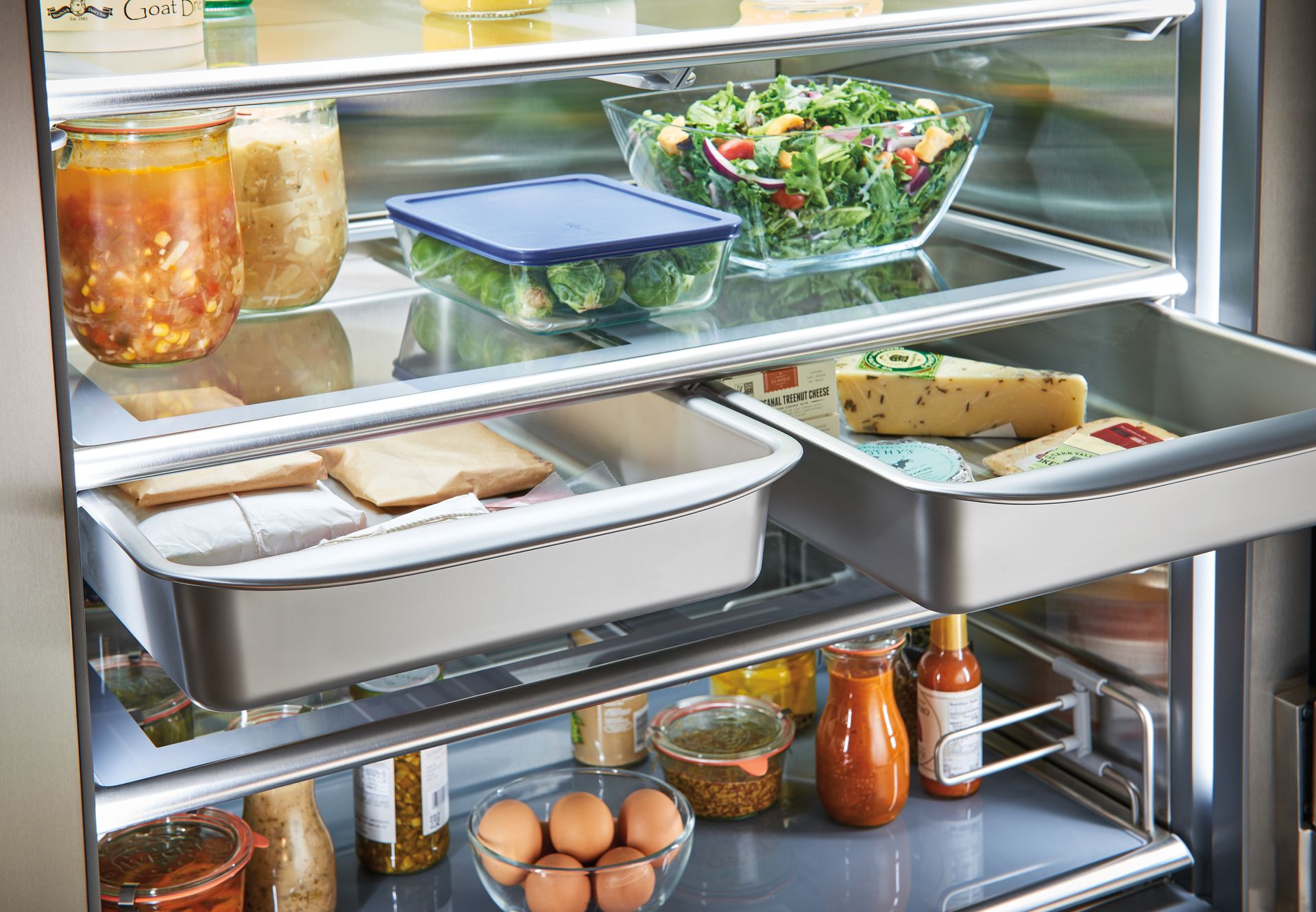
Some foods can taint the taste of others, so it’s always worth taking care to wrap and seal smelly foods. ‘Strong-smelling cheeses are one of the worst offenders. Keep them contained in a dairy compartment if you have one in your refrigerator, or an airtight, Tupperware-style box if not,’ advises Ricky Davies, director of Sub-Zero.
Also keep the lids tightly sealed on foods that are prone to odor contamination – such as cream and yoghurt. Less stinky cheese, like Cheddar or Port Salut, can be kept quite happily on the middle shelf, along with other dairy items.
Organizing Tupperware storage so that it stacks can help you to a neater, more organized refrigerator, too.
12. Use containers
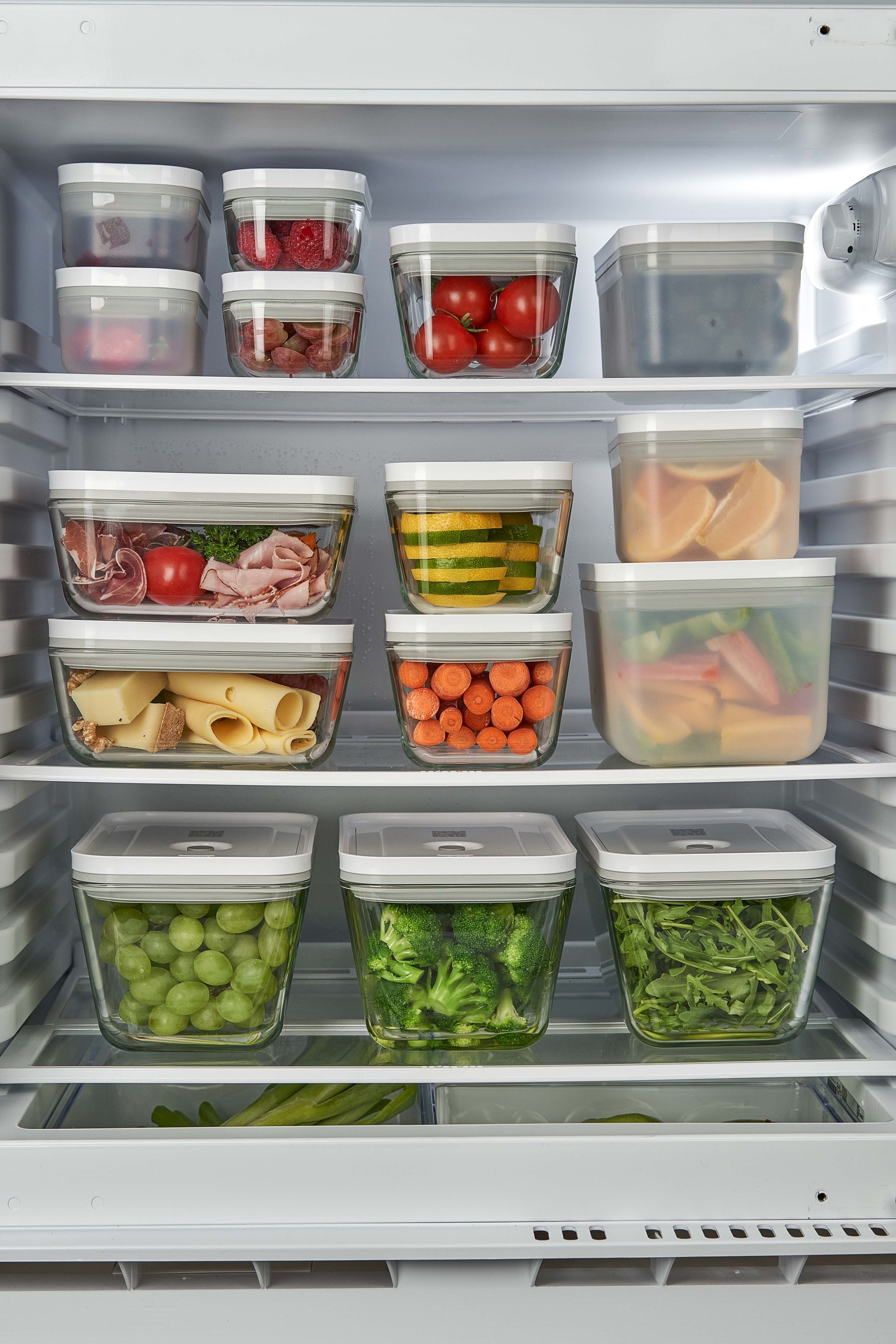
Just as when you are organizing a chest freezer, decanting fresh and leftover produce into containers is undeniably time well spent. ‘Keeping the refrigerator organized using containers not only makes everything easier to find but it also helps stop bacteria growing, turning food bad and potentially making people ill,’ says Paul Bough, in-house chef at Zwilling (opens in new tab).
'By storing fresh produce incorrectly, you are instantly reducing the keep time of your food. Due to exposure to air, the freshness of food is significantly reduced and therefore more is likely to go to waste,' says Jamie Griffin from Insinkerator.
'Containers are the perfect solution to food storage and will help to minimize food waste. Store fresh fruit and vegetables in containers in order to keep it fresh for as long as possible – however, keep a lookout for any items which may be looking less fresh and be sure to remove it if it is within close contact with other produce items to reduce further wastage.'
Choose transparent containers (Ed: we like these stackable clear lidded containers from Amazon (opens in new tab)), ideally made from dishwasher-safe glass or plastic. Stackable containers that are designed to fit together without sliding, and come in a decent choice of sizes, will help you make the most of the space inside your refrigerator. The extra effort will also deliver daily satisfaction every time you open the door to a beautifully stacked and orderly fridge!
13. Keep it clean
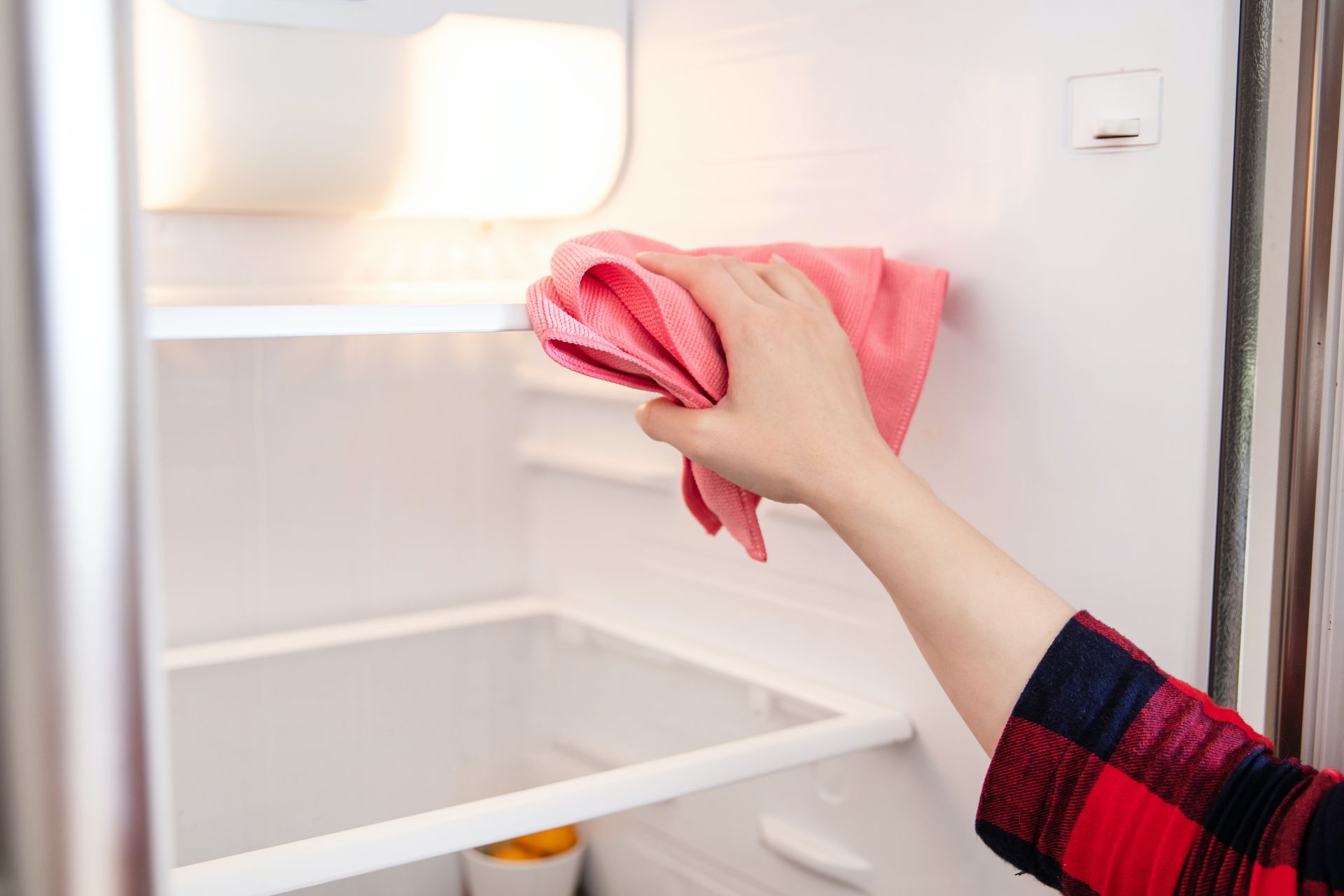
The best way to keep your refrigerator organized is to schedule a regular clean. Done routinely, just before your next grocery shop is due, means any spills or stains will be minimal and the task shouldn’t take long. It also reduces the chances of you coming across expired produce rotting at the back later.
‘By keeping your fridge as clean as possible, you will help to reduce odors, bacteria and mould, all of which will cause your food to prematurely spoil,’ says Ricky Davies, director of Sub-Zero (opens in new tab). You can buy specialist refrigerator liners to make the job a little easier but lining the drawers and shelves with kitchen roll works just as well and will soak up errant spills.
How do you organize jars in the refrigerator?
Once opened, most jars of condiments, sauces, salad dressings and pickles need to be kept in the fridge. As the majority of these ingredients last a long time, the numbers can soon grow, often to the point where it feels like the only food you have in the fridge is jam and pesto.
The best way to organize jars in the refrigerator is to get them all out and check for any repeats. It’s all too easy to grab a fresh jar from the drawer without realizing there’s an open one already. If you have two jars of horseradish open, check if the use-by dates are similar then decant into one jar.
While you have all the jars out, inspect the use-by-dates of each one and check inside for tell-tale signs of mould. Throw anything that’s past its prime into the trash and recycle the jars. Wipe the remaining jars clean and then organize by use-by-date. When you put them back into the refrigerator, put items that need eating first at the front.
The best place to store condiments is in the door of the refrigerator, as they don’t need to be kept very cold. However, if you have too many, the next best option is the top shelf or middle shelves. Try to arrange labels facing forwards so it’s easy to find what you’re looking for and don’t put them behind anything taller or they’ll get lost. Visibility is key to avoid accidentally double up again!
How do I get more space in my refrigerator?
To get more space in a refrigerator when you’re organizing a small kitchen or because it’s simply undersized, there’s plenty you can do. As above, a clear out of anything that’s gone rotten is a good place to begin. Rearranging the shelf heights, by arranging items according to their height, can also make better use of the entire cavity. Aim to avoid large voids between the top of your foodstuff and the shelf above.
Do seek out specialist space-saving products designed for refrigerator use, such as extra drawers that clip under shelves, plus bottle and can stacking racks. Lazy Susan style carousels are a good way of avoiding lost jars at the back, but they do need to be fully loaded to prevent wasted space.
Keeping close control of refrigerator contents is another great space saver. Tracking items with a list – on the front of the refrigerator or on your phone/device – will help stop accidental repeat purchases.
Finally, check whether there is anything in there that doesn’t need to be refrigerated. Tomatoes, onions, potatoes, eggs, coffee and honey are just a few items that will be happier stored in a cool, dark cupboard.
Linda graduated from university with a First in Journalism, Film and Broadcasting. Her career began on a trade title for the kitchen and bathroom industry, and she has worked for Homes & Gardens, and sister-brands Livingetc, Country Homes & Interiors and Ideal Home, since 2006, covering interiors topics, though kitchens and bathrooms are her specialism.
-
-
 Is your jade plant dropping leaves? Here's how to fix it – according to the experts
Is your jade plant dropping leaves? Here's how to fix it – according to the expertsNurse your Crassula ovata back to health with this easy guide
By Holly Crossley • Published
-
 The curtain color mistakes that could be ruining your entire decorating scheme – here's what to avoid and why
The curtain color mistakes that could be ruining your entire decorating scheme – here's what to avoid and whyThe errors designers see most often – and how you can swerve them
By Sarah Warwick • Published

